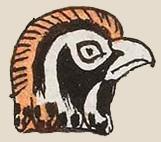zolin (Mdz48r)
This element of the head of a quail (zolin) has been carved from the compound sign for the place name, Tezoltzapotlan. This appears to be a Montezuma Quail. It is in profile, looking to the viewer's right. Its face is black and white. Its head is orange and purple.
Stephanie Wood
As Gordon Whittaker points out, the -zol- element is a phonetic indicator for the adjectival suffix "zol" which means old or wretched. It is not necessarily a place with quail. But as extracted here as just an element of a glyph, it is a quail. See this online photo of a Montezuma Quail, which has the face and chest markings that best match the artist's painting in this glyph. The description of that quail as small and round with a short tail also seems to fit this glyph. The zolin was one of the 13 quecholli, or "representatives of the 13 fate-bearers, each linked to the 13 sacred numbers in the ritual calendar" which included "13 rounds of 20 signs making 260 days," according to Ian Mursell of Mexicolore. The zolin, the 4th of the 13, was associated with the tonatiuh (sun).
The quail had a role in the religious life of the Nahuas, largely serving as offerings. Their remains are very prevalent in the finds at the Templo Mayor, and they are prominent in the Mixtecs' Codex Nuttall. For further information see Elena Mazzetto, "Quail in the Religious Life of the Ancient Nahuas", en Milbrath, Susan y Elizabeth Baquedano (coords.), 2023, Birds and Beasts of Ancient Mesoamerica. Animal Symbolism in the Postclassic Period, Denver, University Press of Colorado, pp. 200-219.
Stephanie Wood
c. 1541, but by 1553 at the latest
Stephanie Wood
quails, cordonices, birds, pájaros

zol(in, a Moctezuma Quail, a bird, https://nahuatl.wired-humanities.org/content/zolin
la cordoniz
Stephanie Wood
Codex Mendoza, folio 48 recto, https://digital.bodleian.ox.ac.uk/objects/2fea788e-2aa2-4f08-b6d9-648c00..., image 106 of 188.
The Bodleian Libraries, University of Oxford, hold the original manuscript, the MS. Arch. Selden. A. 1. This image is published here under the UK Creative Commons, “Attribution-NonCommercial-ShareAlike 3.0 License” (CC-BY-NC-SA 3.0).



